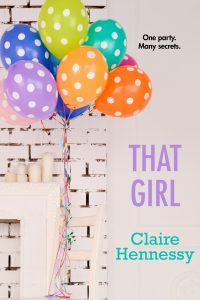Claire Hennessy's Blog, page 9
August 10, 2017
Book Review: The Break
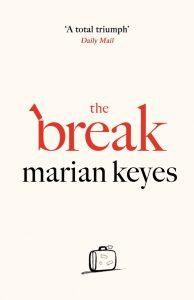 I don’t know if I’ve mentioned this ever but I quite like that Marian Keyes one. By ‘quite like’ I may mean ‘worship the ground she walks on’, etc. Perhaps the most apt example I can give is this: before reading a (gorgeous!) advance copy of her new novel, I was rereading Rachel’s Holiday, a novel that has both entertained and sustained me for the better part of twenty years.
I don’t know if I’ve mentioned this ever but I quite like that Marian Keyes one. By ‘quite like’ I may mean ‘worship the ground she walks on’, etc. Perhaps the most apt example I can give is this: before reading a (gorgeous!) advance copy of her new novel, I was rereading Rachel’s Holiday, a novel that has both entertained and sustained me for the better part of twenty years.
I cannot comment fairly on The Break just yet because I’ve only read it once. Once! How am I supposed to be fair to this baby novel when I haven’t read it at least ten times? How can I compare 40-something Amy to the 20-something Lucy Sullivan that I first read about in my early teens and have held close to my heart into my early thrties, or to any of the Walsh family, or to Lisa & Ashling & Clodagh or Katherine & Tara & Fintan or Grace & Marnie & Alicia & Lola?
How can I even be fair to it in relation to her most recent novel, The Woman Who Stole My Life, which I have read slightly fewer times than the others (maybe four or five or six?)?
Okay. So I have read this book once so far (there will be rereads, rest assured, and probably at least one before the actual publication date). And it’s gorgeous. It’s engrossing and funny and sharp and psychologically astute and all the things you might expect.
Amy is in her mid-forties, and is an unlikely but determined candidate to be working in PR. She splits her work-time between London and Dublin; the latter is where she lives with her second husband, Hugh, her two daughters, and a troubled niece. Dublin is also the hub for her family – a glorious tangle of grown-up siblings trying to be adults and supportive of one another but often not quite getting there.
When Hugh announces he wants a six-month break – an open marriage, effectively – Amy is horrified and angry and yet at the same time all too aware he needs some change in his life. In the past year, he’s lost both his father and a close friend and is struggling with his own mortality. But as the story progresses, we see that there’s been cracks in the marriage, too – that it’s been difficult for both Amy and Hugh to sustain their romance as real life intervenes.
At the same time, there’s family to consider – both the wider circle and the three young ‘uns they need to take care of. The social commentary here is as spot-on as ever, incorporating vlogger-fame, social-justice-speak, and the pared-back-to-the-bone horror of Irish reproductive law.
Amy is not just a mother/carer, though – she’s also struggling with her attraction to other men, and the appeal of the new and alluring (just as Hugh is). She’s slightly less kinky than Stella of The Woman Who Stole My Life, while still very much an unapologetically sexual woman. She’s rounded, is what she is – she’d probably take that to mean her figure (she’s gorgeous, we can deduce that even though she’s hard on herself) but it’s absolutely what her life is. She has a lot going on, this one.
I loved reading this. It was my treat to myself after several weeks’ of not being able to read properly, and oh it did not disappoint. The book is out in September, and I’m pretty sure I’ll have gobbled it all up a second time before then. Marian Keyes is one of our finest modern Irish writers, and I feel so, so lucky to have read this sneakily before its official publication date. Read this. Read all her books. She’s a rockstar.
August 6, 2017
Latest YA reviews
(Irish Times, 5th August)
[image error] [image error]
[image error] [image error]
[image error] [image error]
[image error] [image error]
[image error] [image error]
[image error]
August 3, 2017
Book Review: The Heart’s Invisible Furies
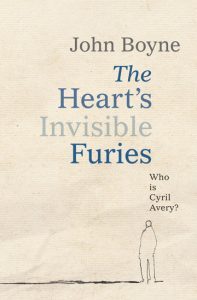
1945: Cyril Avery is born to an unmarried mother, Catherine, amidst much drama. He is not an Avery at that stage, of course. That will only come when he is adopted by a wealthy couple who remind him at every available opportunity that he is not a ‘real’ Avery, and whose manipulations of the law and dramatic tendencies add much humour to the early section of the novel.
Catherine, meanwhile, is working as a tea-lady in the Irish houses of parliament; her path will cross with Cyril’s many times over the forthcoming years. Cyril discovers at an early age that he is attracted to boys, most especially his best friend Julian, and in an utterly glorious sequence, confesses this in excruciating detail to a priest when he’s fourteen years old (the priest collapses in shock before he has time to advise what the appropriate penance for yearning after another boy’s ‘thing’ might be).
Each section is set seven years after the next, and we watch Cyril grow up – get involved with a woman, leave the country, fall in love, witness the death of AIDS victims, experience loss, and finally return home to a much-changed Ireland. But is it too late for him? The final section is set immediately after the marriage equality referendum of 2015; Cyril is seventy now and looks backwards, rather than forwards.
What does it mean to be a gay man in Ireland – and the world – and how has that changed over the years? It’s one of many questions the novel asks, but it does so by taking us on what might be described as a glorious, dramatic, funny and heart-breaking romp. I really, really enjoyed it.
July 27, 2017
Book Review: The Lying Game
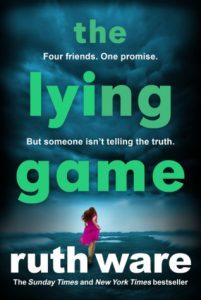
At school, they used to tell lies all the time. Points for getting someone to believe you, for how absurd the lie might be. It’s the kind of thing that groups of teenage girls do, and Ruth Ware depicts the group of friends in an incredibly convincing way. Seventeen years after they’ve all gone their separate ways, they each receive a text message: ‘I need you’.
And as soon as they can, each of them leaves their adult lives behind (with Isa, our narrator, bringing her newborn baby with her) and returns to Salten, where one of them is still living – will never leave, in fact – and where a human bone has recently been discovered.
They know whose bone it is, but the how and why of the death and body-disposal is left towards the end, with sufficient twists along the way to please the reader. This is a read-in-one-sitting book, a page-turner that will resonate with anyone who’s ever been a teenage girl, misfit or otherwise.
July 23, 2017
Now available on Kindle…
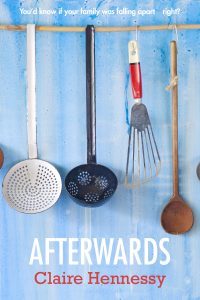
AFTERWARDS (originally published by Poolbeg Press, 2006)
Things fourteen-year-old Claudia worries about:
1) not being as cool as her two best friends
2) not having a boyfriend
3) not being as confident as her little sister
4) not being as smart as her older brother
5) not having anything she’s especially good at
Things Claudia didn’t think she needed to worry about:
1) whether her mum’s happy or not
2) what they’d all do if her mum left
3) whether her mum’s ever coming home
THAT GIRL (originally published by Poolbeg Press, 2007)
Kim’s not the sort of girl who stresses out – usually. But with her sixteenth birthday party coming up, she’s suddenly in panic mode. What if no one turns up? What if friends from different groups don’t get along? What if her overly-anxious stepfather – convinced that teenage parties lead to alcoholism and orgies – ruins everything?
It’s not as though there’s anything else on her mind. Definitely not anything to do with her boyfriend, Eddie, who’s absolutely perfect for her – an actual knight in shining armour (he even takes fencing lessons). And most definitely not anything to do with her brother’s best mate Michael, who knows her too well to ever look at her as more than just a friend . . . right?
July 20, 2017
Book Review: Mrs Fletcher
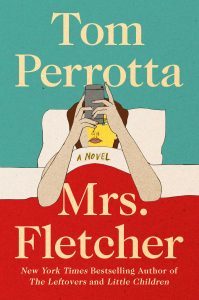
Tom Perrotta, how do I love thee, let me count the ways . . .
Eve Fletcher is about to send her only son, Brendan, off to college. His girlfriend’s over at the house for one last round of shenanigans and she somewhat mortifyingly overhears him: “suck it, bitch”.
It’s not okay to talk to women like that, she thinks angrily, but the whole topic is far too embarrassing and awkward to address immediately, so off they go to his new dorm room where she is quickly encouraged to leave and let him make friends with the guys around him. Brendan soon realises, however, that frat-boy behaviour is not the sort of thing the young feminist women at college will put up with.
Meanwhile, a lonely Eve receives anonymous texts describing her as a ‘MILF’, prompting her to seek out websites to discover what exactly that might be. An obsession develops, and she attempts to distract herself by signing up for an adult-ed class focusing on gender and society.
The social commentary and satire is at times a little too gentle for my liking, but there’s so much in here to adore, as both mother and son learn to live in their respective brave new worlds, and make mistakes along the way.
July 13, 2017
Book Review: Life Moves Pretty Fast
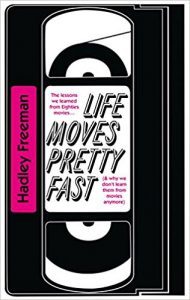
Journalist Hadley Freeman delves into the movies of the eighties – the movies she loved growing up – and explores not only what made them work at the time, but how movie-making culture has changed since then. Drawing on a mix of interviews, academic research and personal anecdotes, she discusses a variety of movies and the issues they addressed – for example, Dirty Dancing and its handling of abortion and female sexuality, Ferris Bueller’s Day Off and the treatment of class within American cinema, When Harry Met Sally… and the smart rom-com.
The essays are interspersed with more light-hearted lists, like the most memorable quotes or best rock songs from eighties’ movies. This is a thoughtful but accessible look at the stories that are told and how the increasing corporatisation of the film industry has impacted on what’s made for mainstream audiences today. For anyone who loves pop-culture analysis that doesn’t get overly-academic, this is a delightful read.
July 11, 2017
Virtual Tour – Joyride To Jupiter – Nuala O’Connor
I’m a big fan of Irish writer Nuala O’Connor, whose thirteenth (!) book is out now. Joyride to Jupiter is her fifth short story collection, but several of the stories will be familiar to those who’ve kept an eye on recent significant Irish writing anthologies (Town and Country from Faber; the Irish-focused issue of Granta). She also writes novels and poetry, and constantly has wise things to say about this business (and art) of writing. So I asked her to share some of them…
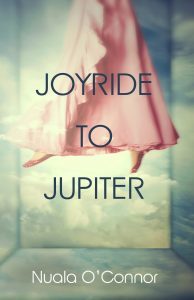
This is collection number five of short stories for you, not counting the ‘Of Dublin and Other Fictions’ chapbook – how has your writing process changed since starting out?
I have slowed down a bit, though to be honest, I am still mostly in a tearing rush: to get to the desk, to write, to get onto the next thing. It’s inbuilt in me to go at things fast.
But I’ve consciously worked on slowing down. To flesh out the work more, to linger over ideas/inspirations rather than harry them into being. To try not to be hysterical about time, which I always want more of. Also, I have fewer story ideas these days, and none for poems. Novels, however, are breeding in me like rabbits.
How many of the stories were commissioned (I imagine ‘Joyride to Jupiter’ was, for one) and how many did you write ‘for yourself’?
‘Joyride to Jupiter’ began organically, actually. I had no deadline. I started writing it on a bus in Croatia where I was a guest at a short story festival. But then I had to finish it to a deadline when I was asked for something for the Faber anthology. Luckily the timeframe was long. I find tight deadlines hard – I prefer for stories to grow at their own pace, whatever that may be.
Ten of the nineteen stories were commissions but only one was prescriptive – it had to be about a getaway as it was for the Irish Times’ summer series of stories. I knew I had a notebook from a trip to Spain that I hadn’t used anything from, so I delved into that and wove my fertility traumas into those Spanish snippets and that became the story ‘Storks’. The deadline was alarmingly short but I was happy with how the story turned out, which is a rarity. Thank goodness for untapped notebooks.
All of these stories have been previously published in anthologies and journals, some translated – do you spend much time on that ‘business’ side of writing, sending work out or thinking about where might be a suitable home for your stories?
In the last few years I have been neglecting that end of things, mainly because I haven’t had many stories to offer. I’m so consumed by writing novels that there isn’t the space in my schedule to write stories unless someone comes looking for something. I couldn’t say no to Granta, for example, just because I’m disgustingly protective of my novel-writing time.
Now that I’ve cleared a bit of space in my schedule, to promote Joyride to Jupiter, I find I’m writing short fiction and flash more consistently again. I’m trying to take my time over one story that may, in fact, end up being a novel because the subject matter is so juicy. But, for the moment, it’s a fragmented story and I’m giddily happy writing it.
Do you revise these stories before they make their way into a collection or do you stay faithful to the first-published version?
I revise like a madwoman so the stories, while not hugely altered, are different to the first-published version. Frank O’Connor was a consummate tinkerer – I’m the same. I read aloud, I use my thesaurus, I aim for clarity. I love the distance that editing a collection allows. These stories span seven years or so. So getting to rework some of them has been very enjoyable.
Who reads your work before it goes out into the world?
My writing group, The Peers, but finished stories and poems only – I don’t bring work in progress, or novel chunks, to my group. Then my agent sees my stuff, then whichever editor. I don’t have a writing buddy or first reader, though I give book proofs to my friend Karen, my husband Finbar, and my sister Úna as soon as I get them and I like that those three are my first ‘book’ readers.
Flash fiction is a great love of yours, and several of these stories are flash pieces. What about the form appeals to you?
It suits a writer like me who is addicted to concision, brevity and precise language. I love that it’s a hybrid, poetry-prosey form. I love that it has visible edges and, when done well, it gives the gut-punch I crave as a reader.
You’ve also been working on novels these past few years – do stories serve as a welcome break from larger projects? What are the challenges of each?
I wrote my first novel in 2003 and didn’t get it published until 2010. That seven year hiatus messed with my novel confidence, so I continued to write stories. I love both, though I’m more naturally a short story writer. I like the day-in, day-out slog of novels, the sense of A Big Project, the working out of plot (sadly there has to be one), and the weaving of strands. The vital, pressing nature of stories mean they are more difficult to pull off, but I like the challenge of them, the novelty. I like newness – in life experience, in surroundings – so the renewal that the story offers thrills me.
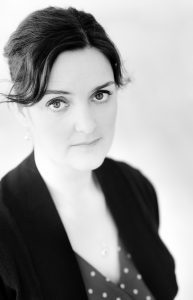
This is – I believe – the first short story collection and second book under the Anglicised version of your name. How is life as Nuala O’Connor treating you – is there any sense of an identity crisis or a betrayal of the oul’ Irishness?
There was a shit-storm on Twitter when I reverted to my birth name, from a bunch of Irish writers whom I shall not identify. Betrayal of identity, blah-fucking-blah. These people don’t even know me; they’d be better off writing books rather than bitching about what I do, imo…
My editors in Penguin USA and Penguin Canada, and my agent, thought my books would be better served if potential readers could read, remember and pronounce my name. Very sensible. For consistency, seeing that Miss Emily did well, we agreed that I should continue as Nuala O’Connor, which is my name. (I went to a Gaelscoil and my name was translated when I entered it, as happens. I studied Irish in uni up to MA. Hence the ‘Ní Chonchúir’.)
Which writers have impressed you recently?
Our own Mary O’Donnell is a wonderful writer – I am currently reading her re-issued first novel, The Light Makers, launching in Dublin 18th July at the IWC. It’s so wise, and also beautifully written and imagined. I recently loved books by American writers Jennifer Tseng and Danielle Dutton, and English writer Sarah Perry. Other recent reads from writers who always impress me were by Alison MacLeod, Mia Gallagher, Jan Carson and June Caldwell. Super writers, all.
If you could change one thing about ‘the Irish literary scene’, what would it be?
Male domination. The boys’ club. It makes me crazy. Yes, the women are great for mutual support, but we are side-lined constantly in favour of male writers (by the men themselves and by the media). People will say this is not true and cite examples of women who have risen to the top, but they are the exceptions. In general, our culture supports male artists to the detriment of female. This is a fact.
Nuala O’Connor AKA Nuala Ní Chonchúir was born in Dublin; she lives in East Galway. Her fifth short story collection Joyride to Jupiter was published by New Island in June 2017. Penguin USA, Penguin Canada and Sandstone (UK) published Nuala’s third novel, Miss Emily, about the poet Emily Dickinson and her Irish maid. Miss Emily was shortlisted for the Bord Gáis Energy Eason Book Club Novel of the Year 2015 and longlisted for the 2017 International DUBLIN Literary Award. Nuala’s fourth novel, Becoming Belle, will be published in 2018.
July 8, 2017
A few bits and pieces…
Some things:
had the chats on the Dave Fanning Show about Harry Potter (scroll down on that page and you’ll find the clip)
had more chats about optimism, writing, creativity & more for Born Optimistic
did a blog interview about many shiny things
did another blog interview about other shiny things
I was interviewed for this piece (along with many others) about Irish women writing YA fiction
latest thoughts on YA fiction that you need to read
July 6, 2017
Book Review: Eleanor Oliphant Is Completely Fine
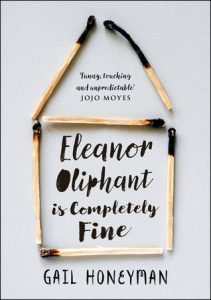
Eleanor Oliphant is not completely fine at all. She is lonely, and yearning, but also surviving; it’s not until the twin shocks of becoming involved in the life of an old man she helps save and the falling in love from-afar with a musician that she begins to question her ordered, old-fashioned lifestyle.
Eleanor is the kind of woman we all hate or perhaps, less powerfully, dismiss in real life. She’s a weirdo. She is petty about money, and supremely awkward about social interactions. She is the sort of human we don’t like and don’t want to. And yet, in this narrative, she is our heroine. This is a novel that reminds us of the power of stepping inside someone else’s head, and the empathy that ensues – a novel that reminds us of the power of fiction.
Eleanor has been through some dark times, darker than most. And yet her observations about ‘normal’ life – from her bewilderment at getting a bikini wax to the nuances of eating at a fast-food restaurant – are universal, a reminder of the little weirdnesses we take for granted. She is both peculiar and familiar, a woman trapped by loneliness in this strange modern world who we can’t help but want to save.

